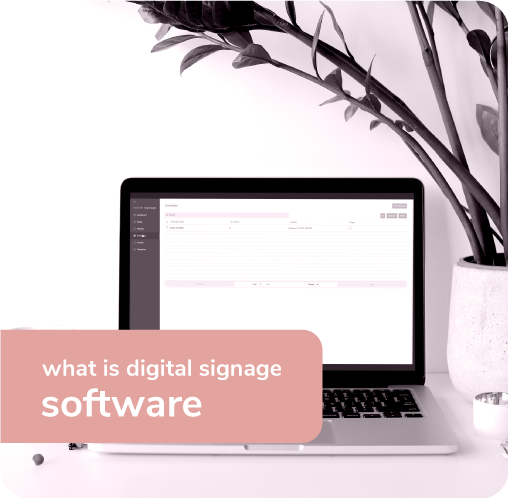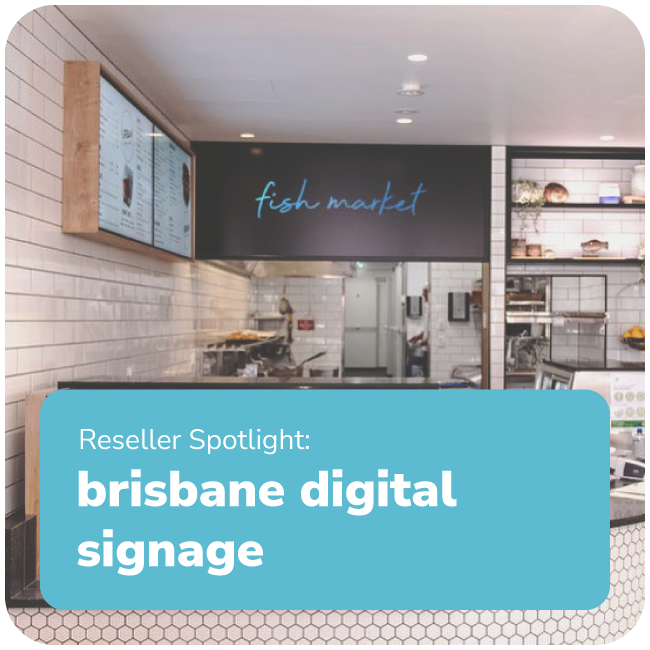Digital signage software is a cloud-based tool that allows you to send images, videos and other...
what is digital signage?
Chances are, you have seen or interacted with some form of digital signage and not even known it. Being in the industry, our brains are fine tuned to see digital signage everywhere we go. But most consumers don’t realise exactly what it is.
Integrating digital technology into physical environments can be as simple as putting a screen on your wall. But is there more to it than that? Of course there is!
painting the picture
I find whenever I explain what we do to people outside of the digital signage industry, it’s often a completely new concept to them that, once they realise what I’m talking about, it flicks a switch in their brains to realise they see it everywhere. All it takes is asking if they have walked into Subway or McDonald’s lately and noticed digital screens instead of printed menus? Or if they have ever used the touchscreen kiosk at Westfield to find a store? Or seen the bus timetable change on the screens at the station?
All of these are examples of digital signage, unique to one another yet all made up of the same four main components: Displays, Media Player, Software, and Content.
We, at Fusion Signage, are one component of a digital signage solution; the software.
let's map it out
1. Display
Displays are the technology powering your solution, ranging from an LCD screen, projector or LED. Firstly, it’s important to know there is a difference between a residential TV and a digital signage display. Choosing a residential TV to use in your commercial space, will immediately void the warranty as it is not intended for commercial use. All digital signage displays will come with a minimum 3-year commercial-grade warranty and are designed to run from 16 to 24 hours a day. These digital signage displays come in sizes ranging from 10” up to 98”, and can be tiled into video walls with very thin bezels. They also include features like being able to run in portrait orientation, have on / off scheduling built in, proper heat management, and can come with media players built in to reduce additional costs. One of the most important factors is the brightness: panels start at 350nit and can go up to 2500nit for outdoor direct sunlight applications (standard TV’s are usually 100nit). Choosing the right display will ensure you have a fit-for-purpose solution, with minimal hassles.
2. Media Player
A media player is a small computer that sits behind your screen and displays your content. These days, media players are often built into the digital signage displays (referred to as System on Chip), reducing additional points of failure as well as cost. If you have an older screen, or are using a projector or LED, then choosing the right media player will save you a lot of headaches. There are Android TV boxes you can buy from retail stores, however these aren’t built to be used in commercial environments and often aren’t able to auto-load applications. The most common commercial media players are Android based, however Windows and Linux can be used if you have a bit more money to spend, or have more demanding graphical requirements. Whichever player you choose, make sure your CMS (see Software section below) is compatible to run on the operating system (including having the correct version of operating system), and make sure your screen has the right input (HDMI / Display Port etc..).
3. Software
Some form of digital signage software (otherwise known as a CMS or Content Management System) is required to distribute content to your screens. Choosing the right software can make or break your digital signage experience. There are literally hundreds of options available at varying price points and complexity. You should firstly understand what content you are going to show, how often you want to update it, how many screens you need to manage, and how much you want to pay. Choosing a more complex and robust CMS may seem like a good idea, but if you need to consult the manual each time you do an update then you will quickly find you aren’t updating your content – resulting in loss of engagement.
4. Content
Every digital signage project should start with a conversation about content. Whether it’s simple images, video or animations, a custom touchscreen application, or immersive projection mapping onto a building, the content drives the solution and ultimately determines the technology required. It’s what your audience sees and relates to, helping to sell your message. Content can be images, videos, templates, websites, text, photos and so on. Understanding the content you want to display is the first step to developing a digital signage solution. If you don’t know what you are going to show, you can’t ensure you have the right solution. Making sure your content is the right duration, orientation, and displayed at the right time of day will increase the relevance to your customer. Don’t put a 15 minute video somewhere where your viewer will only see 10 seconds of it. At all times think about the one message you want to deliver to a viewer, and make sure that is prominent at all times.
examples of digital signage
I hope you now have an understanding of what digital signage is and how it comes together. I’ll leave you with a few examples of digital signage solutions; all made up of those same four components but with different purposes and outcomes. If you have any questions at all, don’t hesitate to get in touch.
Single Screens





Digital Menu Boards



Videowalls


Kiosks


Interactive Walls
Projection Mapping
industry terms explained
Bezel
“…and can be tiled into video walls with very thin bezels.”
The frame around a screen. The more modern a design is, the thinner the bezel will be. Video wall displays have the thinnest which is currently at around .44mm in the LG range.
Nit
“Panels start at 350nit and can go up to 2500nit…”
Units of brightness.
add a little something extra to your fortnight ✨
The bi-weekly insight. A bi-weekly email. From us, to you.
(But only if you want it).
Sign up below.




